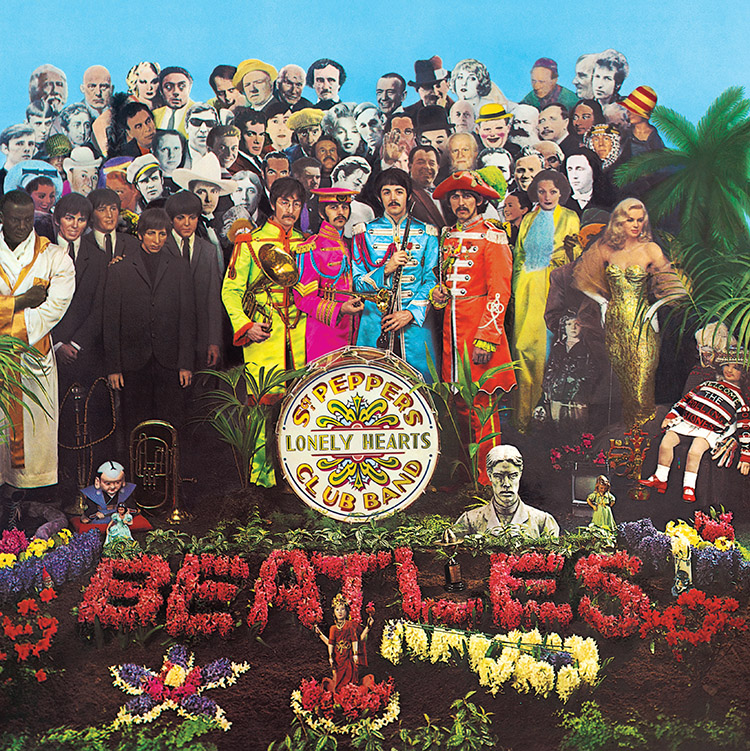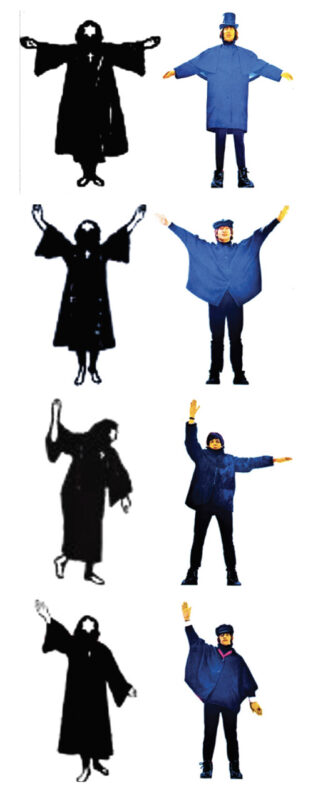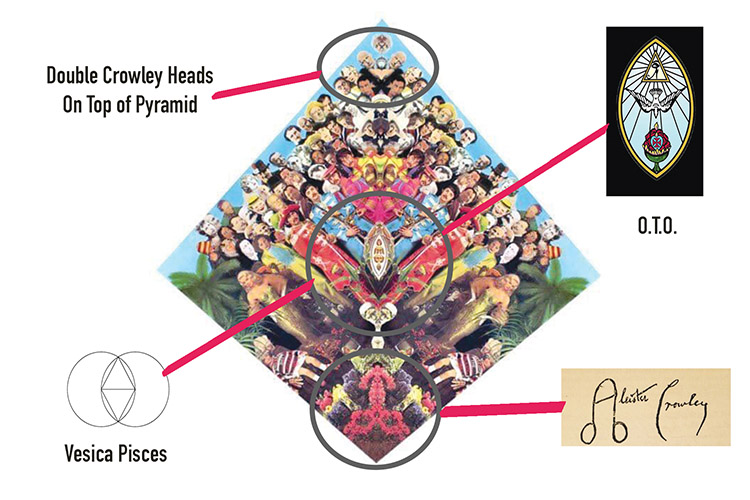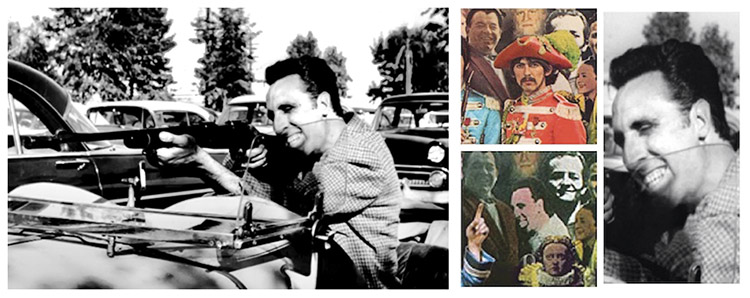 Submitted by Radical Rob on
Submitted by Radical Rob on

Album cover for Sgt. Pepper’s Lonely Hearts Club Band
Aleister Crowley’s penchant for photobombing some of the world’s most infamous conspiracies is often a topic for debate, but in the present case the analogy can be taken quite literally – Crowley’s mug is planted squarely on the Beatles’ Sgt. Pepper’s Lonely Hearts Club Band.
Of course, this album cover is one of pop culture’s most iconic images. Our present focus relates to Crowley’s involvement in the ‘Paul is Dead’ (P.I.D.) conspiracy and, more generally, his influence on the Beatles as a whole.
The Fab Four are the cornerstone of modern-day pop culture, which for some makes them inextricably linked with the nefarious workings of the Establishment. As we shall find, Mr Crowley managed to worm his way into the centre of this alleged rotten apple. But as with all things “conspiracy,” a vast gulf lies between what is real and what is indulgent fantasy.
Back in the summer of 1969, rumours of Paul McCartney’s death began circulating like wildfire on college campuses across the United States. To wit, Paul was killed in a car crash on the M1 motorway on 11 September 1966 and was secretly replaced by a look-alike double to keep the money rolling in for band and country. The band, however, felt obliged to leave hints attesting to the fact to appease their guilty conscience.
On 17 September 1969, Des Moines’ Drake Times-Delphic published the first known article on the subject, “Is Beatles’ Paul McCartney Dead?” It listed some of the hidden clues and messages on Beatles records hinting at Paul’s demise, like a voice uttering “Turn me on, dead man” whilst “Revolution 9” was played backwards.
Radio station disc jockeys spread the message, and soon mainstream media got hold of the story, pushing the Beatles for comment. Ringo Starr told the press, “If people are gonna believe it, they’re gonna believe it. I can only say it’s not true.” John Lennon, for his part, simply said the rumours were “insane.” A CBS News crew secretly filmed McCartney working on his farm in Scotland, followed by a pair from Life magazine. Paul busted the reporters skulking on his property but relented to an interview, telling them:
“Perhaps the rumour started because I haven’t been much in the press lately. I have done enough press for a lifetime, and I don’t have anything to say these days. I am happy to be with my family and I will work when I work. I was switched on for ten years and I never switched off. Now I am switching off whenever I can. I would rather be a little less famous these days.”
After the Life cover story, the “Paul is Dead” rumours began to die down, but they never really went away. Today, over 50 years after the death “hoax” started, McCartney is back on top and quite ubiquitous. You’ll find him on the Billboard charts with the album McCartney III (2020). In bookstores with The Lyrics: 1956 to the Present (2021). In theatres and streaming on Disney+ with the Peter Jackson-directed The Beatles: Get Back (2021). Headlining Glastonbury 2022.
Rumours of his premature demise are also back in full swing. Numerous books, YouTube videos and blogs pay slavish devotion to analysing every detail of the conspiracy, sensing something sinister lurking behind the “cute” Beatle.
Maybe that sinister something has a name – Aleister Crowley. Crowley, however, died shortly after any of the Beatles were born, so how could the “Wickedest Man in the World” pull the strings of the world’s greatest band? Let’s begin the investigation with the name itself.
Beatles with an ‘A’
The Beatles, it seems, have always been shrouded in mystery. This goes for the origins of the band name. “Beatle” is a clever pun imbued with various permutations of meaning. How did it come to be? John Lennon claimed that he and Stu Sutcliffe came up with the name in a nod to Buddy Holly and The Crickets. John said in a 1964 interview: “It was beat and beetles and when you said it, people thought of crawly things, and when you read it, it was beat music.” On another occasion, John stated, “It came in a vision – a man appeared on a flaming pie and said unto them ‘from this day on you are Beatles with an ‘A’.”
Some researchers claim there is more to the name than meets the eye. They reference a poetry collection by Aleister Crowley, published in 1910, entitled The Winged Beetle, which includes occult-themed poems like “The Wizard Way,” “The Octopus,” “The Two Secrets and The Wings.” They note how Paul, after the break-up of the Beatles, went on to form the band Wings. Is Paul the “Winged Beetle,” and were the Beatles acolytes of Crowley’s system of Magick, with a “K”?
It is not unusual to find rock stars openly professing their admiration for Crowley (i.e. Jimmy Page, David Bowie, Ozzy Osbourne, etc.). As we know, Crowley is on the cover of Sgt. Pepper. One rumour has it that “Sgt. Pepper” was a reference to Crowley himself. The opening lyrics to the album are… “It was 20 years ago today when Sgt. Pepper taught the band to play.” That album came out on the 20th anniversary of Crowley’s death. Is the band hinting they are disciples of the Great Beast 666? Crowley’s axiom is, “Do what thou wilt is the whole of the Law,” and “Love is the Law, love under will.”
In an interview with Playboy, John Lennon stated: “The whole Beatle idea was to do what you want, right? To take your own responsibility, do what you want and try not to harm other people, right? Do what thou whilst, as long as it doesn’t hurt somebody.” In 1967, they added “All You Need Is Love” to the repertoire.
What kind of influence did Crowley have over the Beatles? Consider the band’s innovation in the field of backmasking, a recording technique in which a sound or message is recorded backwards to be played forward. The first time such a thing was accomplished was in 1966 during the Beatles recording of the Revolver album. In Magick in Theory and Practice, Crowley instructed the Adept to do the following:
(“a”) Let him learn to write backwards, with either hand.
(“b”) Let him learn to walk backwards.
(“c”) Let him constantly watch, if convenient, cinematograph films, and listen to phonograph records, reversed, and let him so accustom himself to these that they appear natural and appreciable as a whole.
(“d”) Let him practice speaking backwards; thus for “I am He” let him say, “Eh ma I.”
(“e”) Let him learn to read backwards. In this it is difficult to avoid cheating one’s self, as an expert reader sees a sentence at a glance. Let his disciple read aloud to him backwards, slowly at first, then more quickly.
(“f”) Of his own ingenium, let him devise other methods.
In addition to their innovation in the studio, Crowley may have influenced the band’s lifestyle, most evident during their post-1965 “experimental” phase. Crowley was notorious for his drug use, indulging in alcohol, heroin, cocaine and psychedelics. Coupled with his libertine views on sexuality, Crowley could be viewed as the quintessential rock star, decades before such creatures roamed the earth. The Beatles, of course, encompassed all the cliches of rock stardom, for good and ill.
Here Comes the Sun King
Crowley’s philosophy holds the key to our discussion, a philosophy heavily rooted in ancient Egyptian mythology. Crowley understood the significance and sacred symbolism of the beetle. In Egyptian mythology, the scarab or dung beetle was believed to be the incarnation of the beetle-headed god Khepera, who ruled over resurrection and fertility, symbolic of the rising sun, rebirth and creation. Synchronistically, if not consciously, the Beatles would carry the mandate of Khepera and become the sun centre of our musical universe.
The scarab beetle may also hold the key to the ‘Paul is Dead’ mystery. This small insect is associated with an ancient Egyptian god by its curious habit of rolling dung, from east to west, into a ball, into which it lays its eggs. When hatched, the dung provides its young with food. This process of transforming the dead matter of dung into renewed life represents initiation in the Egyptian mysteries. Paul’s “death,” rather than being literal, should be interpreted as symbolic of initiation.
The candidate for initiation represents Osiris who was murdered by his brother Set. Osiris’ consort Isis reassembles his body and then gives birth to the resurrected god Horus, thus completing the cycle of death and rebirth.
It is possible the Beatles were preparing us for Paul’s symbolic death before he was “officially pronounced dead” in September 1966. Let’s go back to 1965 and look at the cover of the Beatles fifth studio album Help! Robert Freeman, who photographed its cover, explains: “I had the idea of semaphore spelling out the letters ‘HELP’. But when we came to do the shot, the arrangement of the arms with those letters didn’t look good. So we decided to improvise and ended up with the best graphic positioning of the arms.”

Did the cover of the Beatles Help! album encode references to Crowley’s system of magick? Hooded figures in a Tau robe in Crowley’s Liber O vel Manus et Sagittae sub figurâ VI seem to match the figures on the album’s cover.
In semaphore, the Beatles are spelling out the letters N-U-J-V. Basically, gibberish. But what if the band were not using semaphore but rather a totally different system? Crowley’s Liber O vel Manus et Sagittae sub figurâ VI contains images of a hooded figure in a Tau robe posing in various positions. Each position conveys a different meaning.
In a video appearing on the YouTube channel “Iamaphoney,” these pictures are superimposed over the cover of Help! It’s pretty much a perfect match. Let’s take a closer look at what these body positions mean when interpreted through Crowley’s system.
John Lennon, with both arms raised, signifies “Osiris Risen – the Pentagram.” Ringo, holding one hand up and one hand down, signifies “Earth – The God Set fighting.” George, with both arms spread out, conveys “Isis mourning – the Svastika.” And Paul, with one arm raised and the other lowered, represents a close approximation of the position, “Typhon – The Trident.”
Could it also be possible that the loose-fitting jackets the Beatles are wearing on the cover of Help! are a hipster’s interpretation of the Tau robe?
If you think these concepts are a little far-fetched, understand that the occult was a big deal in 1966, as it was with the Beatles themselves. This is evident on their 1966 masterpiece, Revolver, whose working titles included Abracadabra, Magic Circle and Four Sides of the Circle.
The word Abracadabra plays a central role in Crowley’s philosophy. “Abrahadabra” in The Book of the Law is “the Word of the Aeon,” meaning the Great Work accomplished and the all-important “attainment of the Knowledge and Conversation of one’s Holy Guardian Angel.” In addition, the word represents the uniting of the Microcosm with the Macrocosm.
It Was 20 Years Ago Today
Many people are familiar with the ‘Paul is Dead’ clues. Let’s touch upon some of the better-known ones on Sgt. Peppers to bring us up to speed. The album cover undoubtedly presents a funeral ceremony. On the grave, pictured in the lower portion of the cover, red flowers spell out the word “Beatles.” This is traditionally interpreted to mean that the Beatles, with the death of Paul McCartney, are now “dead.”
Take note as well that on the cover we are presented with a set of Beatle doubles. Two sets of Beatles stand over the grave. The older phase Beatles, to the left, look over the grave mournfully. Dressed in drab coloured suits, they are in fact wax figures made by Madame Tussauds.
The second group of Beatles, standing in the centre, are the new phase Beatles. They are dressed in bright clothing, looking very much alive because they are in fact the Beatles standing there in the flesh. Here we are presented with the ‘new’ Paul McCartney, the replacement double as it were, who will carry the band into new psychedelic frontiers, etc.
Below the red flowers is a group of yellow flowers in the shape of a left-handed bass, Paul’s bass of course. There are three strings on that bass. One is missing. Paul is missing.
While the other three Beatles carry brass instruments, McCartney carries a cor anglais, a double-reed woodwind instrument. This has been interpreted as a symbol of death. As well, Paul here is “out of step” with the other Beatles, just as he is on the cover of Abby Road. The interpretation is that Paul walks amongst the dead. In the corner, next to a doll wearing a “Welcome the Rolling Stones” jumper, is a reddish driving glove symbolising McCartney’s bloody car crash death.
These are popular clues and lots of fun to play with, but the proof of the pudding linking P.I.D. to black magician Aleister Crowley is a revelation never before written about.
We all know, of course, that Crowley is on the cover of Sgt. Peppers, one of many famous people pictured, and seemingly was placed randomly in the back row. However, if you split the cover diagonally and mirror it, a remarkable thing happens. At the very top of this diamond-shaped image sits Crowley. His head predominates over everyone else.
Right at the bottom of the cover you see the flowers form an insignia that is identical to the ‘A’ which Crowley used in his signature and is famously portrayed in the shape of a penis. Sex magick, it should be noted, was a central component of Crowley’s teachings. And in the middle of the cover is the emblem for Crowley’s mystical organisation – the O.T.O.
The palm tree on the right side of the album now appears on both sides forming a border. This symbol, especially significant in Freemasonry, refers to the two pillars Boaz and Jachin that are said to have stood on the porch of Solomon’s Temple. This is a remarkable image. To put that all together indicates, in my opinion, a level of genius.

The Smoking Gun
Recently, a veritable treasure trove of material has been released from the Beatles’ camp showing behind-the-scenes photos of the production of the Sgt. Pepper’s album cover. These photos reveal something very interesting. In my estimate, the smoking gun – both literally and figuratively – and final clue regarding the ‘Paul is Dead’ mystery.
The Beatles hired Michael Cooper as the principal photographer for the album cover. The photoshoot occurred at Cooper’s London studio at 4 Chelsea Manor Studios, 1-11 Flood Street off King’s Road in Chelsea.
Paul McCartney came up with the album title Sgt. Pepper’s Lonely Hearts Club Band. He based the concept for the album cover on an old photograph showing Paul’s father’s old orchestral band standing around a bass drum that read Jim Mac’s Band.
Peter Blake and his wife Jann Haworth designed and assembled the set. Finally, after eight days of preparation, on 30 March 1967, the Beatles arrived at the studio where Cooper shot them as they posed in front of various life-sized cardboard cut-out photographs of famous people.
What we discover in these behind-the-scenes photos is that some of these life-sized cut-outs did not appear on the official album cover because they were behind another cut-out or behind a band member. Behind George Harrison is one of these obscured characters. Indeed, on the album cover, we catch only a glimpse of this figure peering out from behind the right side of Harrison’s head.
Now, with the aid of these photos, we can identify this person to be film actor Timothy Carey. The image is, in fact, taken of Carey specifically from one scene in the Stanley Kubrick film The Killing (1956).

Timothy Carey in The Killing (1956).
The cut-out shows Timothy Carey holding a rifle, and in the movie Carey plays a hired hitman working with a group of criminals. They have a plan to rob the racetrack of its earnings and Carey’s job is to shoot one of the horses to cause a distraction.
On the cover of the album, the image of Carey is obscured by George Harrison. The barrel of the gun actually extends all the way behind Paul McCartney who is standing next to Harrison. If you gauge it, you can see that the barrel of this gun is pointed directly behind the heart of Paul McCartney.
No one knew about this for over 50 years. Yet, curiously, the choice was made to use an image from this Kubrick film to symbolise, I would suggest, the ‘killing’ of the lead racehorse – as Paul McCartney could indeed be equated to a very profitable lead racehorse. A smoking gun indeed.
What does it all mean? What does it add up to? We are left with room for conjecture. Perhaps, as some researchers suggest, the Beatles were part of an elaborate plan by the elite to condition the youth of the Western world to accept the coming ‘New Aeon’. Others would assert it is a method of social engineering akin to the use of MK-ULTRA but applied on a mass level. Certainly, the symbolism draws a direct link to the inner workings of the Mystery Schools and the teachings of Aleister Crowley.
Andrew Arnett - https://www.newdawnmagazine.com/articles/the-beatles-aleister-crowley-the-mystery-of-paul-is-dead
© Copyright New Dawn Magazine, www.newdawnmagazine.com. Permission granted to freely distribute this article for non-commercial purposes if unedited and copied in full, including this notice.
© Copyright New Dawn Magazine, www.newdawnmagazine.com. Permission to re-send, post and place on web sites for non-commercial purposes, and if shown only in its entirety with no changes or additions. This notice must accompany all re-posting.